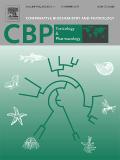Kennedy, Christopher J.
Related Works
Content type
Digital Document
Abstract
The neuroprotective effects of inducing the blood-brain barrier ATP-binding cassette protein transporter P-glycoprotein (P-gp) with clotrimazole (CTZ) in both fed and fasted zebrafish (Danio rerio) against the CNS-toxicant ivermectin (IVM, 22,23-dihydro avermectin B1a + 22,23-dihydro avermectin B1b) were examined. Zebrafish were administered 2 μmol/kg IVM intraperitoneally, and various behavioural assays (swimming performance, exploratory behaviour, olfactory responses, motor coordination, and escape responses) were used to measure neurological dysfunction. IVM administration alone caused a decrease in mean swim speed (91 % of controls), maximal speed (71 %), passage rate (81 %), 90° turns (81 %), and response to food stimulus (39 %). IVM exposure also increased the percent time that fish spent immobile (45 % increase over controls) and the percent of lethargic fish (40 % increase). Fish administered 30 μmol/kg of the P-gp inducer CTZ intraperitoneally 3 d prior to IVM exposure exhibited a change in only the % time spent immobile. These data indicate that P-gp induction may be limited in protecting the zebrafish CNS from IVM over baseline. Fasted fish did not differ from fed fish in the effects of IVM on behaviour, and no differences were seen following P-gp induction with CTZ. These results suggest that this chemical defence system is not downregulated when fish are challenged with limited energy availability.
Origin Information
Content type
Digital Document
Abstract
Alterations in ivermectin (IVM, 22,23-dihydro avermectin B1a+22,23-dihydro avermectin B1b) toxicokineticsfollowing P-glycoprotein (P-gp) induction by clotrimazole (CTZ) were examined in rainbow trout (Oncorhynchus mykiss) to assess the potential importance of P-gp activity levels in xenobiotic distribution and kinetics in fish. Control and fish pretreated with CTZ (30 µmol/kg) were administered 175 µg/kg 3 H-IVM into the caudal vasculature. At various time points (0.25, 0.5, 1, 3, 24, 48, 96, and 168 h) following injection, tissues (blood, liver, kidney, gill, intestines, brain [5 regions], eye, gonad and fat) were removed analyzed for IVM-derived radioactivity. IVM concentration declined in blood, liver, kidney and gill, and concentrations in other tissues remained constant over the sampling period. The highest measured concentrations were found in kidney, followed by liver, with the lowest values found in brain, eye and gonad. The highest % of the administered dose was found in the liver and kidney in the immediate hours post-administration, and in the intestines and fat at 24 h post-administration. P-gp induction by CTZ did not alter IVM distribution or any calculated toxicokinetic parameter (AUC, mean residence time, T 1/2 , clearance rate, volume of distribution), suggesting that P-gp induction may be limited or that P-gp plays a lesser role in xenobiotic kinetics in fish compared to mammals.
Origin Information


